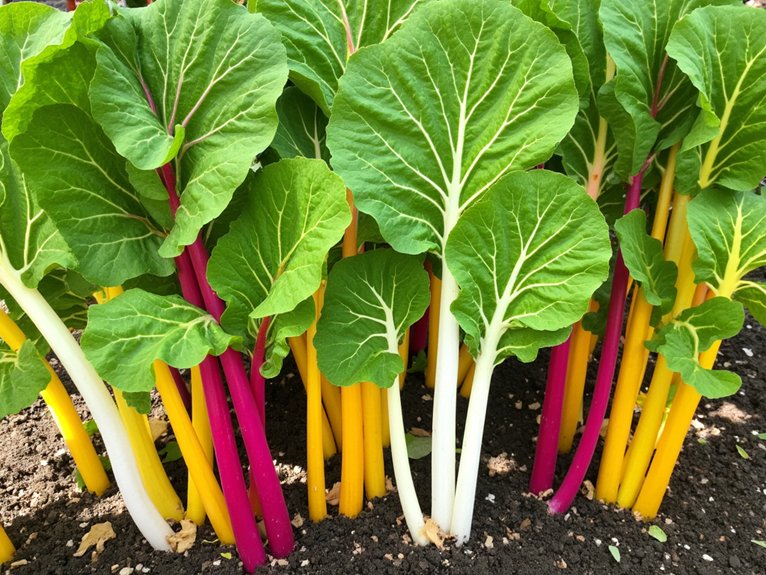When Master Gardener Sarah Chen planted her first ‘Bright Lights’ Swiss chard, she transformed her garden into a living rainbow with stems in gold, crimson, and magenta hues. You’ll discover that Swiss chard isn’t just another leafy green – it’s a versatile powerhouse that can thrive in temperatures from 40°F to 90°F and produce for up to 8 months straight. From compact container varieties to towering 24-inch specimens, these stunning plants will revolutionize your growing space and kitchen possibilities.
Contents
- 1 Why Swiss Chard Belongs in Your Garden
- 2 Essential Growing Tips for Swiss Chard Success
- 3 Top Color-Rich Swiss Chard Varieties
- 4 Best Swiss Chard Cultivars for Heat Resistance
- 5 Nutrition and Health Benefits of Swiss Chard
- 6 From Garden to Table: Cooking With Swiss Chard
- 7 Expert Tips for Year-Round Swiss Chard Harvests
Why Swiss Chard Belongs in Your Garden

When you’re looking to maximize your garden’s productivity, Swiss chard stands out as one of the most rewarding vegetables you can grow. This versatile green offers you continuous harvests throughout the season, as it regrows after cutting. You’ll appreciate its bolt resistance during hot summers when other greens struggle.
Beyond its reliability, Swiss chard enhances your garden aesthetics with striking stems in vibrant colors. It’s perfect for seasonal planting in spring or fall, and you’ll find endless possibilities for culinary creativity. The large, manageable seeds make it beginner-friendly, while minimal fertilizer needs keep maintenance simple.
Essential Growing Tips for Swiss Chard Success
Although Swiss chard thrives in most conditions, you’ll achieve the best results by following essential growing guidelines from the start. Begin with proper soil preparation by working in compost and aged manure to a depth of 12 inches. Space your plants 12-18 inches apart in rows 18-24 inches wide.
For effective pest management, monitor leaves regularly for leaf miners and aphids. “A quick spray of neem oil solution can prevent most pest issues before they escalate,” notes master gardener Sarah Chen. Water deeply but infrequently, applying 1-2 inches weekly at the base to prevent leaf diseases.
Top Color-Rich Swiss Chard Varieties

Swiss chard’s vibrant colors can transform an ordinary vegetable garden into a stunning display. When you’re looking for colorful chard varieties, start with ‘Bright Lights,’ which features stems in gold, pink, orange, and purple. For dramatic chard aesthetics, try ‘Peppermint’ with its striking candy-striped stems or ‘Pink Lipstick’ with its magenta stalks. ‘Rainbow Sprinkles’ offers a complete spectrum of hues perfect for containers and borders.
Plant these varieties 12 inches apart in full sun, and you’ll enjoy both their ornamental appeal and nutritional benefits. Master gardener Tom Smith notes, “These vibrant varieties taste as good as they look.”
Best Swiss Chard Cultivars for Heat Resistance
Growing chard in hot climates requires selecting cultivars that won’t bolt quickly under intense summer heat. You’ll find success with Lucullus, a proven heat tolerant variety that thrives when temperatures soar. Fordhook Giant also performs exceptionally well, maintaining productivity even during long, hot summers.
For the best growing conditions in warm regions, consider these resilient cultivars:
- Perpetual Spinach Chard: Resists bolting up to 85°F
- Charbell: Maintains leaf quality at 90°F
- Barese: Compact variety perfect for hot climates
- Red Magic: Shows excellent heat tolerance through 95°F
Plant these varieties 12 inches apart in well-draining soil with afternoon shade for ideal results.
Nutrition and Health Benefits of Swiss Chard

Beyond selecting heat-resistant varieties, you’ll want to understand the powerful nutritional benefits that make Swiss chard a standout in your garden. The nutritional profile of this leafy green packs a serious punch – just one cup of cooked chard delivers over 300% of your daily vitamins A and K requirements. You’ll also benefit from its rich antioxidant properties, which help fight inflammation and boost immune health. Load up on essential minerals like calcium, magnesium, iron, and potassium when you add chard to your meals. Plus, you’re getting cancer-fighting compounds that make this veggie a true “supergreen.”
From Garden to Table: Cooking With Swiss Chard
Once you’ve harvested your Swiss chard from the garden, you’ll discover its incredible versatility in the kitchen. Different cooking techniques bring out unique flavors – try sautéing the leaves with garlic for a quick side dish or adding chopped stems to stir-fries for extra crunch.
For delicious recipe ideas, separate the stems from leaves before cooking. Blanch stems for 2-3 minutes, then add leaves for another minute. You can also braise whole leaves in vegetable stock, blend them into smoothies, or layer them in lasagna. The mild, earthy flavor pairs well with lemon, nuts, and strong cheeses like Parmesan.
Expert Tips for Year-Round Swiss Chard Harvests
Although many gardeners treat Swiss chard as a seasonal crop, you can enjoy continuous harvests throughout the year with proper planning and techniques. Stagger your plantings every 3-4 weeks using different chard varieties to guarantee steady production.
Master Gardener Sarah Chen explains: “Plant cold-hardy varieties like ‘Perpetual’ in early spring, heat-tolerant types like ‘Fordhook Giant’ for summer, then return to cool-season performers for fall.”
For winter harvests in zones 7-10, protect plants with row covers. In colder regions, establish plants in cold frames or greenhouses. You’ll maintain fresh chard access regardless of season.
